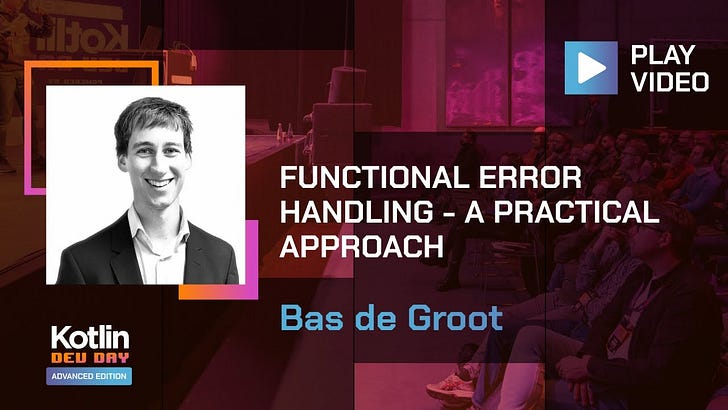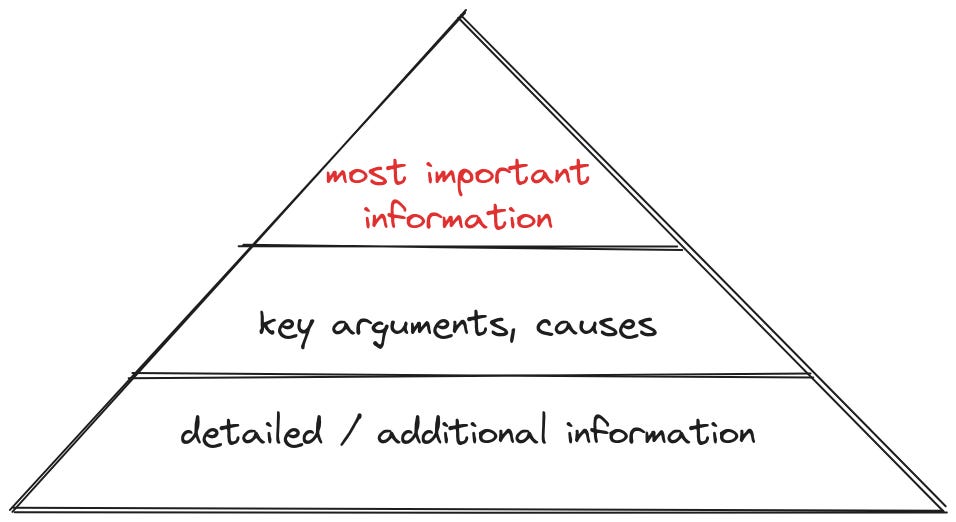Minto Pyramid, Talk Recommendation and Slow Productivity - Weekly Tech Tidbits #3
Master Clear Communication, Incident Management Tips, and Cal Newport's Slow Productivity Principles in One Read!
Hi, it's Mirco! 👋 Welcome to this week's edition of Weekly Tech Tidbits. In today's post, we will cover three interesting topics:
Efficient Communication with the Minto Pyramid 📐
Key Takeaways from Kat Gaines' Talk on Incident Communication 🎤
Insights on Slow Productivity from Cal Newport's New Book 🐌📕
Enjoy reading and feel free to share your thoughts in the comments below. Don't forget to subscribe for more insights and share this post with your network! 📢
Efficient Communication with the Minto Pyramid
The Minto Pyramid is an effective framework for structuring written communication, particularly useful in incident communication.
The structure is fairly easy:
Main Point (WHAT): State the incident and its immediate impact in 1-2 sentences.
Key Information (WHY | HOW): Provide details such as the cause of the incident or steps being taken to resolve it.
(Optional) Additional Details: Include further information that might interest specific stakeholders, like technical logs or timelines.
Here is an example incident communication using this principle:
Service X has been unavailable since June 12, 2024, affecting approximately 15% of our users.
Incident Overview
Cause: Our investigation indicates that the outage is likely due to a load balancer failure.
Actions Taken: A technical team is currently working to resolve the issue.
Estimated Resolution Time: We expect the service to be restored within the next 2 hours.
Additional Details
Several restarts and configuration checks have already been performed to isolate the issue.
By using the Minto Pyramid, you can ensure your incident communications are clear, concise, and effective, providing essential information promptly and accurately.
Key Takeaways from Kat Gaines' Talk on Incident Communication 🎤
My example above may not be very useful for end customers. I am biased toward incident communication like this since I work on internal software that is not directly customer-facing, unlike my company's website. However, everyone also has internal customers, and most likely not all of them are techies.
This requires another level of incident communication. Kat Gaines from PagerDuty recently gave a short talk on this topic.
Here are the key takeaways:
Involve customer-facing teams as soon as possible: They know your customers and how to communicate with them (around minute three)
Have pre-defined templates that are easy to fill out: This will reduce the stress during an incident while keeping stakeholders and customers informed (around minute fifteen)
Give frequent and meaningful updates: Keep notification fatigue in mind(Around minute nineteen)
Kat's talk is only 25 minutes long, so it can fit into your lunch break. Alternatively, you can use the timestamps provided above to get the main gist.
Slow Productivity 🐌📕
I am an avid reader, and since 2021, also a listener of Cal Newport's ideas. I can warmly recommend everyone to read his famous book “Deep Work” and listen to his podcast.
A couple of months ago, he published his new book called “Slow Productivity”. Main topic of the book is that the definition of productivity in the knowledge sector is broken. He refers to this as “pseudo productivity”. Since there is no good way to measure productivity (as opposed to a factory worker who can be measured by produced “units” per hour), many knowledge workers use visible business as a proxy for productivity, e.g. by joining a lot of meetings and there like.
Cal wants to coin an alternative approach which he calls “Slow Productivity” as another way to see productivity in knowledge work. Slow Productivity is based on the three principles
Do Fewer Things: Focus on fewer tasks to achieve more meaningful accomplishments.
Work at a Natural Pace: Avoid the constant rush and instead find a sustainable rhythm.
Obsess Over Quality: Prioritize high-quality work over high-quantity outputs.
While I think the overall content of the book is just fine, I was a little bit disappointed. The book is full of anecdotes which act as anecdotal evidence for the principles, but they are far too long and frequent. On could easily reduce the page count of the book by 25% without loosing any of its meaning. Also, many of the ideas feel like a rehash of content Cal Newport already produced.
So if you are familiar with Cal Newports ideas, I’d suggest to read the Blink or another summary first.
Wrapping Up
Thank you for reading this week's Weekly Tech Tidbits. Here's a quick recap:
Efficient Communication with the Minto Pyramid: Ensure clear and concise incident communications.
Kat Gaines' Talk on Incident Communication: Involve customer-facing teams, use templates, and provide meaningful updates.
Slow Productivity from Cal Newport: Focus on fewer tasks, work at a natural pace, and prioritize quality.
I'd love to hear your thoughts, questions, and feedback in the comments below. 💬 Don't forget to subscribe for more insights 🔔 and share this post with your network! 📢
Weekly Tech Tidbits #2: Disagree and Commit, Spotless, and Error Handling in Kotlin.
Hi, it's Mirco! 👋 Welcome to this week's edition of Weekly Tech Tidbits. In today's post, we will cover three interesting topics: the concept of Disagree and Commit 🗣️✅ how to keep your code tidy 🧼 Typed Error Handling in Kotlin ⚠️🎥 If you missed the previous issue, find it
Stay tuned for next week's post.


